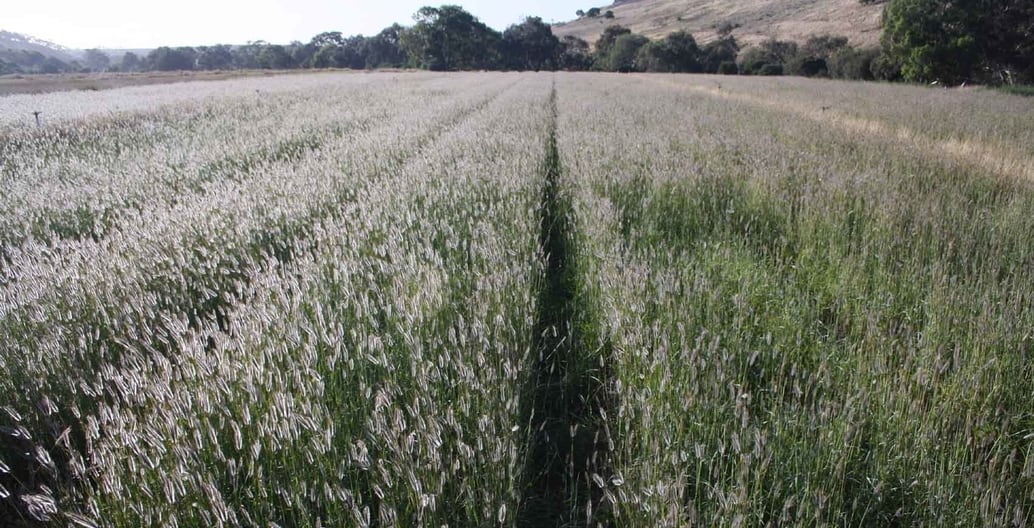
‘Wild’ grasses are in vogue as priceless native grasslands disappear
Native grasslands are under threat world-wide, just as we’re waking up to their environmental worth and realising their commercial benefits. On the volcanic plains north-west of Melbourne, Australia, a small company is battling to revitalise an undervalued ecosystem.
In recent years, luxuriant grasses and meadow planting have featured in some much-loved, award-winning urban projects. From James Hitchmough and Nigel Dunnett’s Southern Hemisphere Garden for the 2012 London Olympics, to Piet Oudolf’s work at the New York High Line and Chicago’s Lurie Garden at Millennium Park, richly diverse, naturalistic plantings of textured grasses and flowering biennials are proving to be a hit with the global public.
Australia, too, has seen a surge of interest in these meadow-esque plantings and their improbable blend of wild and urban, albeit mostly with temporary, smaller urban experiments such as the City of Melbourne’s ‘Landscape Lab’ meadow plantings and the native wildflower nature strips of James Beattie. The Victorian National Parks Association has even produced a popular booklet to support native grasslands in urban areas, compiling the knowledge of amateur and professional enthusiasts, with the help of the Australian Institute of Landscape Architects.
John Delpratt, Remnant grasslands from Mark Newbound on Vimeo.
One of the biggest wild-style hits of recent years was Gone to Seed at the State Library of Victoria forecourt. Here, artist Linda Tegg, working with horticultural scientist John Delpratt and landscape architect Anthony Magen, recreated the pre-colonial grassland landscape of the site, complete with myriad indigenous seeding and flowering species. The installation led to architects Mauro Baracco and Louise Wright collaborating with Tegg to install ‘Repair’, the profuse and gorgeous grassland Australian Pavilion at last year’s Venice Architecture Biennale.
The public interest generated by such high-profile urban projects is significant, but is unfortunately not translating into wider protection or the larger scale projects needed to conserve grasslands, which are both critical sources of biodiversity and a powerful means of carbon capture. Emerging policy and planning is beginning to recognise the environmental need for broad-scale revegetation of grasses and forbs across Australia’s many degraded open landscapes. There is also emerging recognition of the business case for normalising use of native grassy groundcovers in Australian infrastructure and subdivision projects – the same suburban and peri-urban projects destroying indigenous remnant grasslands. However, all this may be too little too late for viable species populations.
It is entrepreneurial private business, volunteer groups and professional bodies who are doing the hard work to change thinking and practices, building the expertise and arguments that are urgently needed in Australia.
Just north-west of Melbourne on a sweeping bend of the Maribyrnong River, Chris Findlay and Graeme Hoxley manage 13 hectares of native grassland for seed harvesting. Flora Victoria has been collecting seed from Melbourne’s western basalt plains for over a decade – from private property with permission, and under licence from public land – carefully recording provenance. Many of these sites have since been obliterated by new development.
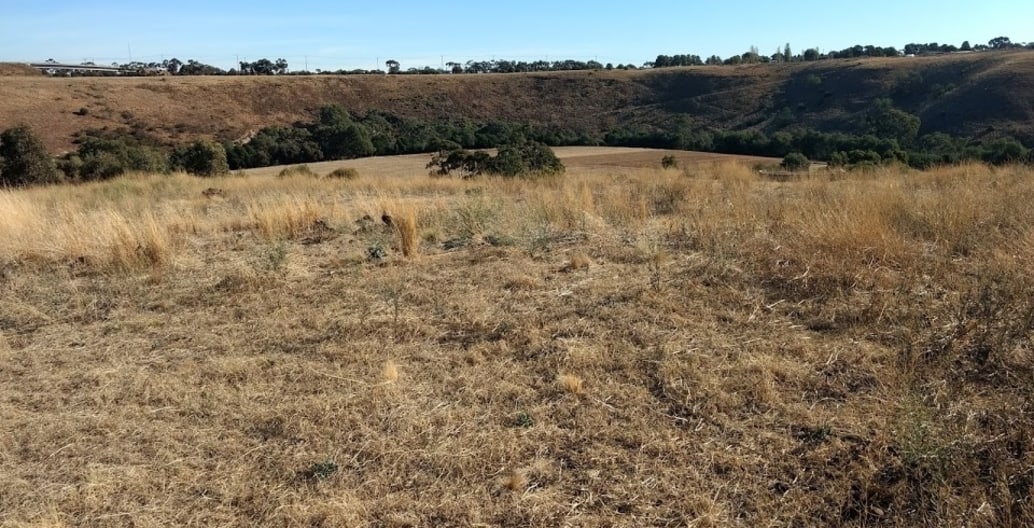
While the work is part of their business, the effort to find and protect the genetic diversity of the most vulnerable ecosystem in Victoria is also a labor of love. Driven by acute concerns for the future of a delicate, rich and beautiful vegetation group, they have also supposed that, over the years, recognition of the commercial and environmental value of grassland species would be worth the investment and greatly expand their work. Unfortunately for them – and the western plains – this hasn’t yet been the case, despite many successes, including Gone to Seed, for which the company provided the eponymous seed.
The big-picture need for grassland revegetation
Many early European explorers and travellers such as Edward Eyre, Ludwig Leichhardt and Thomas Mitchell reported that the open grassy landscapes they encountered appeared ‘naturally’ like the fertile fields of home. As Bill Gammage relates in The Biggest Estate on Earth, these landscapes were the result of extensive land management practices by Australian indigenous peoples. This is not just about the past. Ongoing landscape practices that affect us all today are part of urgent questions giving impetus to political activism, whether involving individual trees, particular sites, environmental systems or global climate.
Deforestation is obvious. It is well-reported and accompanied by dramatic visual evidence. National Geographic has just reiterated a less appreciated, although also long-recognised concern: much of earth’s grassland has been lost to agricultural and other development. Grasslands are easy to clear and develop for a range of purposes. They are usually on flat and accessible plains, close to water and with fertile soil. Historically well-chosen for human settlement, grassy plains have also been swallowed up by expanding urban and suburban building. On top of this, already weak and fragmented grassland ecosystems now face new threats from climate change.
In 2006, only 0.5% of grasslands in Australia remained in good condition. Victoria’s native grasslands and grassy woodlands of the western volcanic plains reflect this statistic. Grasslands are made up of many flowering herbs and forbs as well as grasses. They also support diverse animal life. The Australian Government Department of Environment and Energy identifies numerous rare insects, birds and reptiles that are endemic to particular grasslands.
It was only in 2017 that the Victorian Government committed to establishing two grassland reserves of 15,000 hectares to protect endangered native grasslands and threatened species from Melbourne’s urban growth. Hopefully the Adaptive Management approach that has also been adopted will permit timely informed input from those who are independently accumulating specialist knowledge in this field.
The protection and restoration of remnant degraded grasslands is an understandable priority for ecologists, volunteers and many landholders. But the future viability of many species may well depend on wide commercial interest, rather than small protected conservation sites.
Grassland project diversity and potential
There are many opportunities for native grasslands to flourish in our cities, from the infrastructure spaces under powerlines, along road and rail corridors, and across stormwater drainage, treatment and catchment zones, to suburban open spaces and around recreation facilities.
Flora Victoria has completed projects that range across many scales and functions in both the public and private realms. These include single roundabouts and small native flower gardens, to multi-year trials and direct seeding projects for major infrastructure, such as the repaired dam walls at Hamilton Treatment Plant and other sites for Wannon Water. The business also developed early relationships with local councils, including Brimbank just across the river, Hume, Melton, Hobson’s Bay and Geelong.
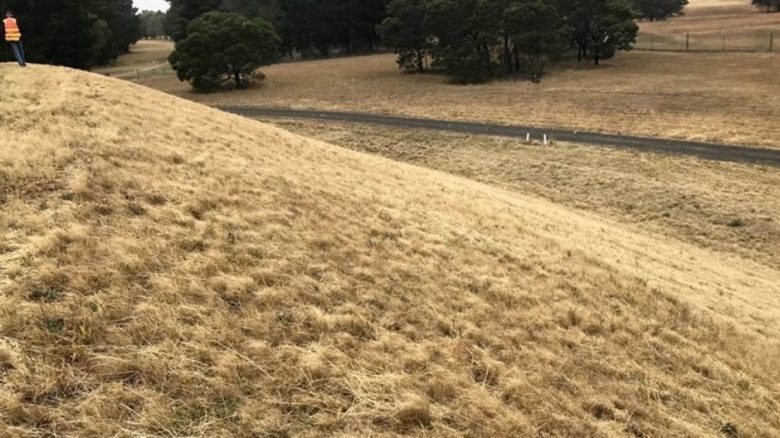
A thick cover of Wallaby Grass covers a Hamilton Treatment Plant dam wall seeded two years ago by Flora Victoria. Image: Flora Victoria
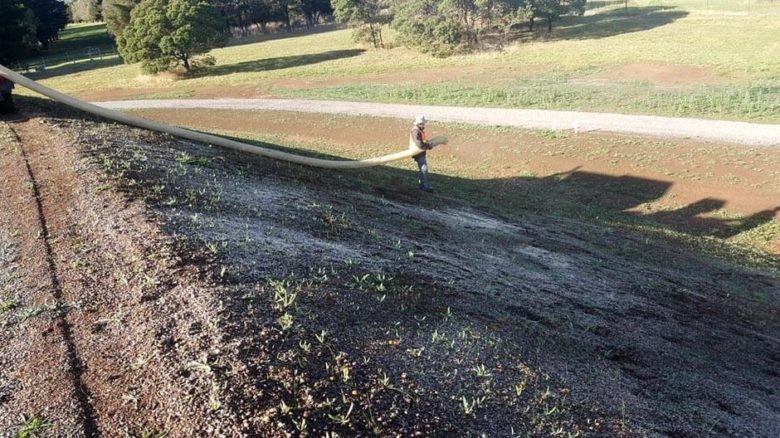
May 2017 seeding of Hamilton Treatment Plant dam walls with Wallaby Grass. Image: Flora Victoria
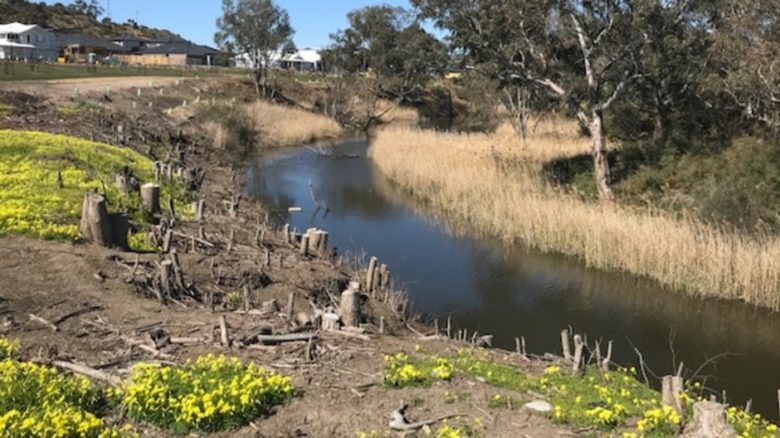
Early weed eradication on residential estate Gen Fyansford, near Geelong by Tract preparing for indigenous planting. Photo: Tract
Working with landscape architects has also helped raise awareness with clients of the value of natives species and direct seeding, especially given the opportunities on larger multi-year subdivision and infrastructure sites to do broad scale direct seeding. Hassell Studio are working with Flora Victoria to establish flowering native grasslands at several level crossing removal sites in western Melbourne. Landscape architects Emma Haberman and Emily Shaw were responsible for driving the grassland concept through rigorous review and approval processes. Emma is quick to list ecological as well as aesthetic and practical maintenance benefits:
“Grasslands are drought resistant, stabilise soils, increase water infiltration, provide habitat for fauna, and once established will inhibit weed growth. They thrive in low-nutrient, saline and acidic soils, and require no fertilisers or pesticides [and] little maintenance – slashing, mowing or burning… only once a year.”
Landscape architects Ashley Sheldrick and Simon Wade of GbLA have been working with Flora Victoria for over ten years on dozens of projects, along with other wetland and native species contractors. Two major projects delivered over several years have had award-nomination and winning outcomes. Wanginu Park, part of Development Victoria’s Jackson’s Hill residential development, received a 2014 National Award for Land Management for “sensitive and beautifully executed restoration of a highly degraded landscape”.
Warralily Creek Corridor Rehabilitation project in Geelong was a finalist in the 2016 Premier’s Sustainability Awards. Part of a new community by Armstrong Creek Development Corporation, the site will have 13 hectares of native vegetation in 3 dedicated conservation zones. Grassy woodland will be restored along the Creek under remnant River Red Gums. After two years of site preparation, Flora Victoria is now waiting for first rains to undertake seeding.
Sheldrick attributes the success of these projects to the long preparation time and client commitment enabling thorough eradication of persistent noxious weeds that plague the western plains. The projects also collected and grew on local provenance seed for revegetation in careful compliance with offset and habitat requirements. And although they have also undertaken more traditional cell and tubestock planting projects, the direct native seeding has been notably successful.
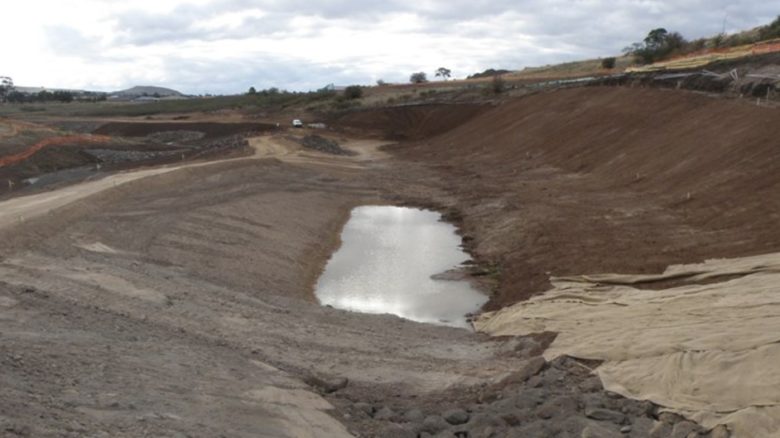
Before: Site preparation for award-winning Wanginu Park north of Melbourne by GbLA. Photo: GbLA
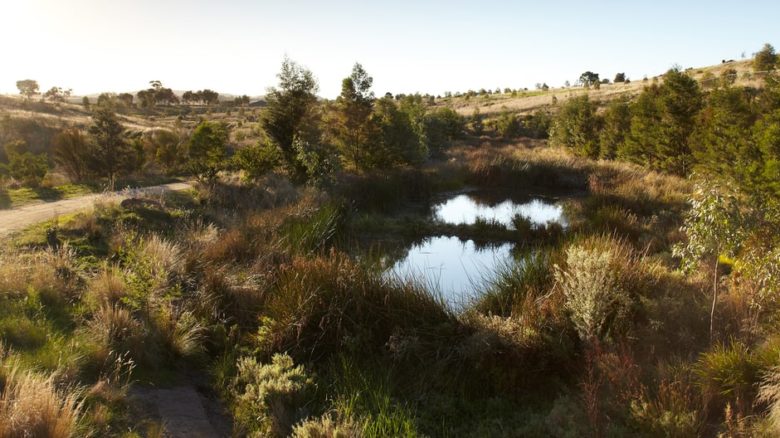
After: Creekline of a government-led residential estate, GbLA's Wanginu Park north of Melbourne has well-established native planting and surrounding grassland. Photo: Andrew Lloyd
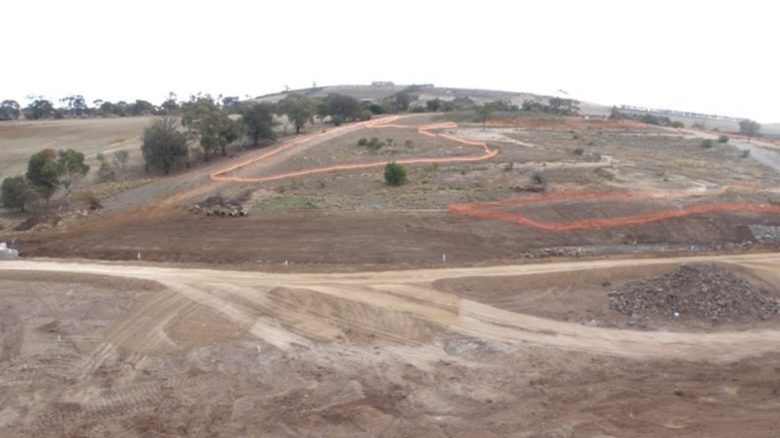
Before: Site preparation including extensive weed removal for Wanginu Park by GbLA at Jackson's Hill. Photo: GbLA
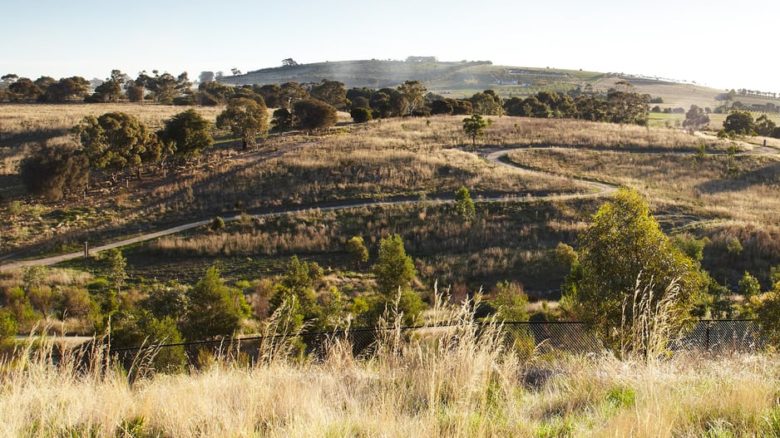
After: Well- established indigenous grassland by Flora Victoria with GbLA at Wanginu Park. Photo: Andrew Lloyd
Landscape architects at Tract have also worked with Flora Victoria on several projects. One of the most significant is a residential estate, Gen Fyansford, near Geelong beside the Moorabool River. Again, a significant regional waterway required rehabilitation over a sustained period. Dave Cameron explained that this linear site suffered from Elm infestation, while shallow rocky soils on some steeply sloping banks made for difficult weed control – the biggest challenge for grassland rehabilitation. Indigenous species replanting and especially direct seeding have made the project work.
Developing grassland expertise
Findlay credits John Delpratt, horticultural scientist at the University of Melbourne, with pioneering direct seeding of indigenous grasses in Australia. Starting with around 25 grasses, Delpratt has been researching and experimenting with species for decades and been a great supporter of Flora Vic. Until recently working with Greening Australia, Paul Gibson-Roy, has also done extensive pioneering work in the area and advanced local knowledge with valuable overseas study. Gibson-Roy’s 2016 Churchill Fellowship took him to the U.S. to examine the successes of a widespread market for native prairie plants and seed, and also witness grassland restoration “recreated in scales unimagined in Australia”. He hopes to see that same value-recognition in Australia.
Building on the knowledge and experience of Delpratt and Gibson-Roy, Flora Victoria has further developed specialist expertise. The preparation of sites for native reseeding is best done by ‘scalping’ or removing the top layer of soil along with the weed seed it holds. Native seed is also happier with less nutrients than is present in topsoil that supports invasive species. Using scalping, direct seeding is then cheaper, provides denser cover and better regeneration rates. The company has developed a custom native grass seeder to blow dry florets rather than individual seeds usually mixed with water and cellulose fibre.
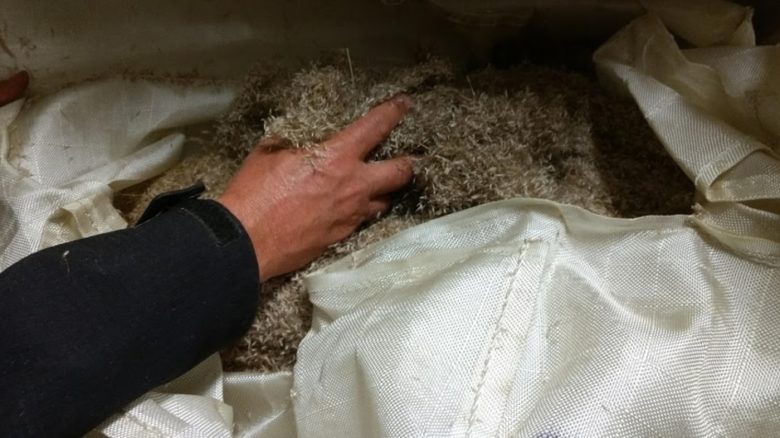
Chris Findlay with harvested native grass seed carefully labelled in temperature-controlled storage.
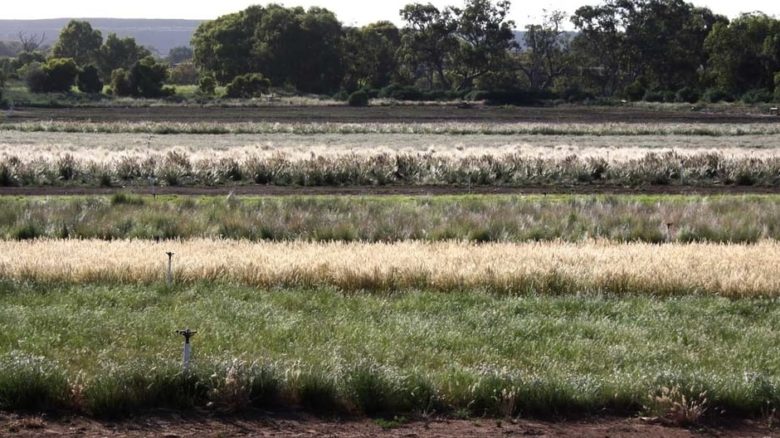
Rows of native grass species grown for seed at Flora Victoria's seed production area just north-west of Melbourne.
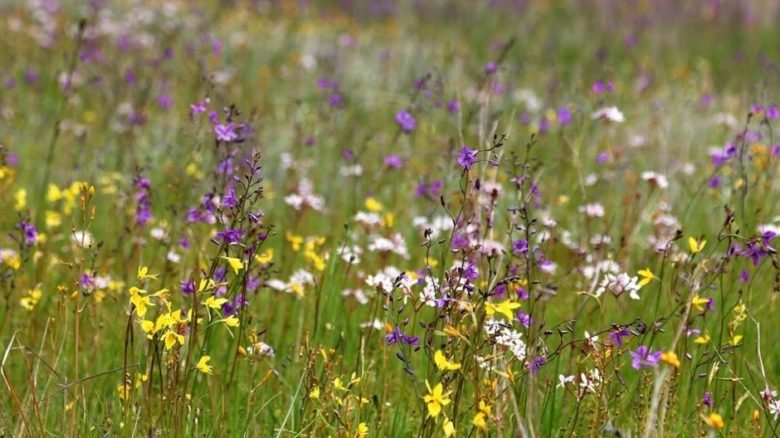
Fragrant purple chocolate lily amongst other indigenous wildflower species will be grown by Flora Victoria for seeding projects.
Ethical seed sourcing is a vital first step in the process of project development as well as ongoing business confidence. Recognising the need for huge volumes of wild species seed to restore ecosystems, Australian researchers have recently called for the development of seed-sourcing regulations. Flora Victoria has sensitively collected wild seed and grown species for its specific seed needs. Its almost unique native seed production once provided seed for other contractors, but the business has now decided to keep control of the whole process to ensure the outcome.
Flora Victoria harvests seed from grasses in distinct plots, which it then stores in climate-controlled conditions, identified by species and provenance. Unlike grasses grown for human consumption of grain, these plants are perennial, regrowing after harvesting each season. The company has now harvested the first seeds from new wildflower trials and is looking forward to displaying the results of some mixed wildflower seeding on site, as well as seeing how upcoming projects will realise its first wildflower projects.
Support needed for the future of grasslands and grassland horticulture
We might need to do more than protect what existing grasslands remain if we’re to prevent a loss of grass species and biodiversity, but new projects at larger scales are uncommon, despite increasingly clear cost and other benefits. Confidence in revegetation techniques is growing, but too slowly.
Findlay believes that the pressures on fragmented remnant grasslands require more radical intervention than typical weed suppression regimes. At great expense, these barely maintain the status quo, let alone increase quality or quantity of grassland sites. Scalping and direct reseeding is proving to deliver better results, but this too takes time. It can be five years before sufficient seed is harvested for a major project, and that capacity requires investment.
Another problem has been implementation of offset planting policies. ‘Offsets’ are state-based planning requirements for the replacement of environment lost to proposed development. Used increasingly as a tool to balance competing demands of development and environment, it has been argued that there is little evidence that offsets are effective, resulting in a net loss of environmental value. They may be poorly implemented, or not implemented as documented, or at all, with inadequate monitoring and compliance checks. Refocusing remote offsetting to deliver more and better localised revegetation, could encourage more interest and responsibility for outcomes. And more enjoyment of them.
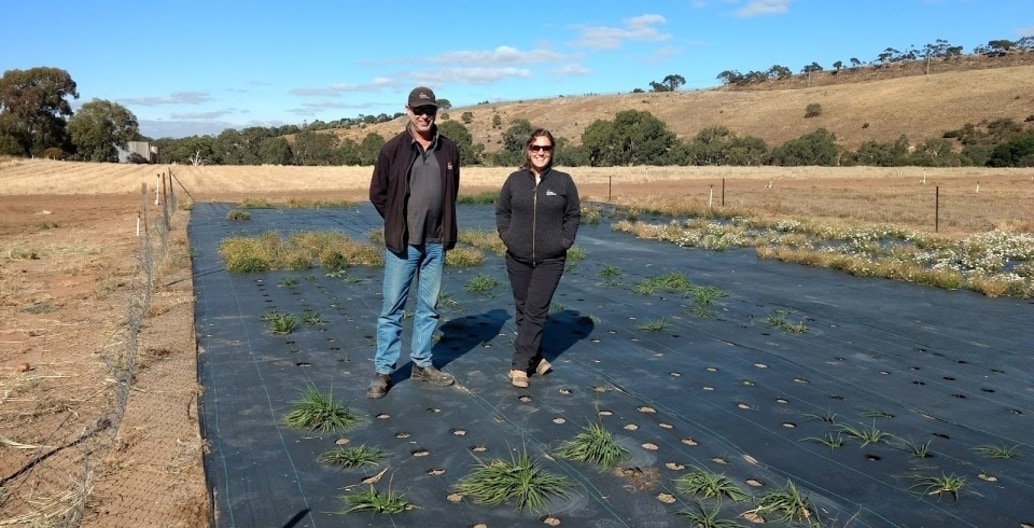
Standing in warm autumn sunlight, with the first scarlet robin of the season flitting by, Findlay and project manager Kate Hill enthuse about the grasses and wildflowers around us and about sharing the beauty of grassland species. But he has concerns for the business. Perhaps wildflowers will help. While grasses have been the starting staple of the research and business, Findlay loves flowers. From a business perspective, he feels they will be much more attractive to a wider variety of clients, both public and private. And diversifying the species mix is ecologically as well as aesthetically beneficial, hopefully drawing attention to remaining grasslands as well as inspiring new ones.
Still, the types and extent of well-managed native grassland planting that Flora Victoria hoped to see by this time have not eventuated, despite some exemplary projects. Perhaps working directly with larger projects that initially erase grasslands will help too. While cautious about dancing with the devil, Findlay believes that working early with clients such as mining corporations will mean bigger, well-funded projects. The future of Victorian grasslands depends on more secure, long-term investment to build a net gain in quality and quantity of an ecosystem on the brink of extinction. This support needs to see the broad value of what it promotes, taking urban novelty to the many suburban and peri-urban sites where it might flourish into the future.


